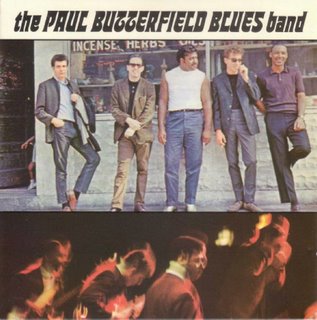A resurgence of interest in the blues occurred during the
1960s both in the United States and in the UK. In England, the most
important figure was John Mayall whose band, The Blues Breakers featured at
one time or another Peter Green, Eric Clapton, Mick Taylor, and Jack Bruce.
Mayall's group did traditional style acoustic numbers (Lonely Years)
as well as covers of standards like Freddie King's Hideaway.

In the
U.S. one of the first blues revival groups was The Paul Butterfield Blues
Band (pictured above) featuring Butterfield on harmonica and vocals and guitarists Michael
Bloomfield and Elvin Bishop. They played a rough Chicago-style blues on
their early recordings.
Other artists from the sixties included Johnny Winter, Canned Heat, and
the Blues Project. More recently, Texas guitarist Stevie Ray Vaughn (died in
1990) enjoyed a lot of success with his band, Double Trouble. Vaughn was a
virtuoso guitarist who covered all kinds of artists from Elmore James (The
Sky Is Crying) to Jimi Hendrix (Little Wing). Another
contemporary blues guitarist that has made a name for himself is
Robert Cray. Growing up in Tacoma, Washington he was inspired when he saw
Texas guitarist Albert Collins perform. The experience led him to devote
himself to the blues and he eventually toured with Collins as well as John
Lee Hooker.
Recently, blues has been featured on television in a series put
together by film director Martin Scorsese (2003 has been officially
designated The Year of the Blues by the U.S. Congress).
Blues is prominent in the HBO series The Sopranos, too. One can
hear the contemporary sound of the Alabama 3 in the opening credit sequence
of each episode. Their sound is similar to that of Mississippi bluesman R.L.
Burnside. Burnside
blends rap mixing techniques with traditional blues to produce an
interesting hybrid.
Elements of the Blues
These are the main characteristics of the blues style:
Lyrics that follow an AAB pattern, improvisation, a 12 bar form, lyrics
that express themes of loneliness, depression, or trouble, the use of "bent"
notes, and the use of the blues scale.
